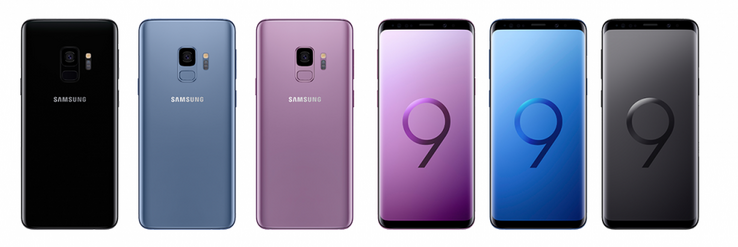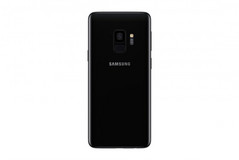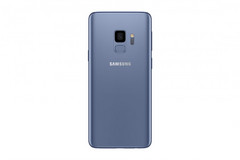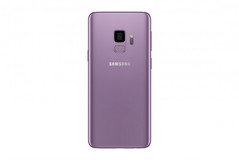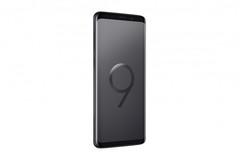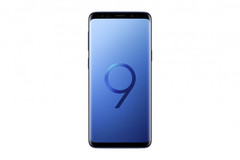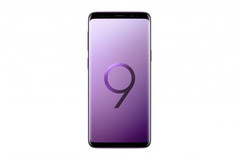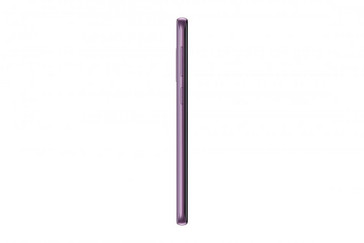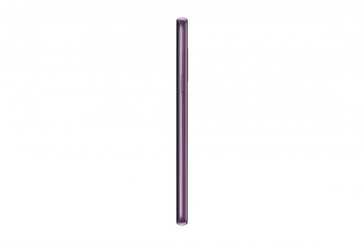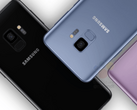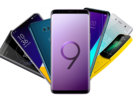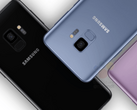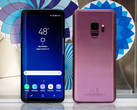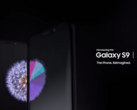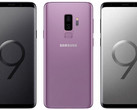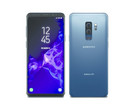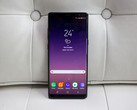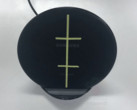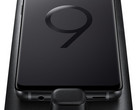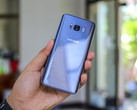news.samsung.com
Built for the Way We Communicate Today: Samsung Galaxy S9 and S9+
Samsung Newsroom (with U.S. Specific News Release) 02.25.18 12-16 minutes
SEOUL, Korea – Feb. 25, 2018 – Samsung Electronics Co., Ltd. introduces the Samsung Galaxy S9 and Galaxy S9+, the smartphones that reimagine the way we communicate, share and experience the world. Made for the ways we increasingly communicate and express ourselves with images, videos and emojis, the Galaxy S9 and Galaxy S9+ drive innovation with Samsung’s most advanced camera ever. Redesigned with a new dual aperture lens that powers an innovative low light camera, Super Slow-mo video capabilities and personalized AR Emoji, the Galaxy S9 and Galaxy S9+ ensure you never miss a moment and make your everyday epic.
The Galaxy S9 and Galaxy S9+ deliver an enhanced entertainment experience with powerful stereo speakers tuned by AKG, surround sound supported by Dolby Atmos and a refined edge-to-edge Infinity Display – a key staple in Samsung’s design heritage. In addition, the Galaxy S9 and Galaxy S9+ will come with the new SmartThings app, which unites Samsung’s existing IoT services into one single, smart experience.
“The way we use our smartphones has changed as communication and self-expression has evolved,” said DJ Koh, president and Head of IT & Mobile Communications Division, Samsung Electronics. “With the Galaxy S9 and S9+, we have reimagined the smartphone camera. Not only does the Galaxy S9 and S9+ enable consumers to shoot the best photos and videos anywhere, it’s a smartphone that’s designed to help them connect to others and express themselves in a way that’s unique and personal to them.”
Camera Reimagined
Today’s cameras are for more than taking pictures – they’re for connecting and communicating. Consumers want a smartphone camera with state-of-the-art technology, so they can express themselves with high-quality images and tools to tell their own, unique story. The Galaxy S9 and Galaxy S9+ cameras are built with these consumers in mind, with a Super Speed Dual Pixel sensor with dedicated processing power and memory that can combine up to 12 distinct images into one amazing, high quality photo. The Galaxy S9 and Galaxy S9+ camera features include:
- Super Slow-mo: Make every day moments epic with dynamic, slow-motion video that captures 960 frames per second. The Galaxy S9 and Galaxy S9+ also offers automatic Motion Detection, an intelligent feature that detects movement in the frame and automatically begins to record – all users have to do is set up the shot. After capturing the Super Slow-mo video, users can select background music from 35 different options.
- Low Light Camera: Good lighting is the secret to any great photo. But often, photos are taken in less-than-ideal lighting conditions and most smartphone cameras have a fixed aperture that can’t adjust to low or bright lighting environments resulting in grainy or washed out pictures. Similar to the way the iris of a human eye expands and contracts, Samsung’s Dual Aperture[1] (F1.5 – F2.4) automatically lets in more light when it’s dark and less light when it’s too bright, taking photos that are crisp and clear anytime, anywhere.
- AR Emoji: Samsung lets users create an emoji that looks, sounds and acts just like them. AR Emoji uses a data-based machine learning algorithm, which analyzes a 2D image of the user and maps out more than 100 facial features to create a 3D model that reflects and imitates expressions, like winks and nods, for true personalization. AR Emoji uses a standard AGIF file format, so users can share their emojis across most third-party messaging platforms.
- Bixby: Samsung’s intelligence platform, integrated into the camera, uses augmented reality and deep learning technologies to provide helpful information about a user’s surroundings.[2] With real-time object detection and recognition, Bixby instantly generates information directly on top of the image that the camera is pointing at. Users can translate foreign languages and currency in real time with Live Translation, learn about their surroundings, purchase products seen in the real world from retailers such as Walmart and Sam’s Club, or track calories throughout the day.[3]
Entertainment Reimagined
Smartphones are often our go-to choice for entertainment, which is why Samsung created a device that offers premium sound experiences with stereo speakers tuned by AKG. Whether users are watching their favorite movie or streaming their favorite artist’s latest album, sounds are clear, crisp and rich in quality. The Galaxy S9 and Galaxy S9+ also support Dolby Atmos enabled surround sound, giving the effect of 360-degree sound.
The Galaxy S9 and Galaxy S9+ audio experience is complemented by Samsung’s revolutionary Infinity Display. First introduced on the Galaxy S8, the bold, bright Super AMOLED Infinity Display blends right into the phone with virtually no distracting bezels. With an adaptive contrast enhancement, users can use their device even in direct sunlight.
A Device that Fits with the Connected Lifestyle
As the first smartphone to support the new SmartThings app, the Galaxy S9 and Galaxy S9+ are the central hub to manage every facet of the connected lifestyle at home, at the office or on the go. The SmartThings App will be introduced with S9 and Galaxy S9+ and will connect to other Samsung and non-Samsung devices.
For those constantly on the move, the next-generation Samsung DeX empowers a mobile lifestyle by bringing a large, full-screen experience to the mobile handset. With DeX Pad, a new docking system, users can easily connect the Galaxy S9 and Galaxy S9+ to a larger monitor, keyboard and mouse to expand the mobile experience with enhanced document editing or even full-screen gaming. Users can transform the Galaxy S9 and Galaxy S9+ into a Touch Keyboard[4] and Touch Pad with the DeX Pad.[5]
The Best Comes Standard with the Galaxy Foundation
Samsung sets the gold standard for smartphones including IP68 water and dust resistance, and fast wireless charging. The Galaxy S9 and Galaxy S9+ go a step beyond. The devices now support expandable memory of up to 400GB and are equipped with the latest premium application processors offering powerful performance, fast network speeds and sophisticated image processing.
In addition, the Galaxy S9 and Galaxy S9+ give users the peace of mind knowing that their phone is protected by Knox 3.1, Samsung’s latest defense-grade security platform. The Galaxy S9 and S9+ support three different biometric authentication options – iris, fingerprint, and facial recognition – so users can choose the best way to protect their device and applications. The devices support Intelligent Scan, a new verification mode that intelligently fuses the collective strength of iris scanning and facial recognition technology to quickly and conveniently unlock a user’s phone in any environment. The Galaxy S9 and S9+ introduce Dedicated Fingerprint, giving users the option to use a different fingerprint to access Secure Folder than the one used to unlock the phone.
Preorder and Availability
In the U.S., Galaxy S9 and Galaxy S9+ will be offered in Lilac Purple, Midnight Black and Coral Blue for carrier and Unlocked by Samsung versions. Preorders begin March 2, 2018. AT&T, Sprint, T-Mobile, U.S. Cellular, Verizon Wireless and Xfinity mobile will carry Galaxy S9 and Galaxy S9+ in stores beginning March 16, 2018, as well as at Best Buy stores and BestBuy.com, Amazon, Costco, Sam’s Club, Target and Walmart. Cricket Wireless and MetroPCS will offer Galaxy S9 and S9+ in Midnight Black. Samsung Galaxy S9 Enterprise Edition will be available in Midnight Black. The new devices will be available beginning March 16, 2018.
Available through Samsung.com and the Shop Samsung app, the Unlocked Galaxy S9 is $719.99 or $30/month for 24 months financing, and the larger Unlocked Galaxy S9+ is available for $839.99 or $35/month for 24 months financing[6].
Starting March 2, 2018, consumers who pre-order a Samsung Galaxy S9 or Galaxy S9+ can save up to $350 with qualifying trade-in[7]. The promotion will last for a limited time and is available at Samsung.com, the Shop Samsung app and select retailers. Visit samsung.com/us/trade-in for more information.
Samsung Premium Care
With Samsung Premium Care, you get more than just protection for your device, you get a team of Samsung pros ready to come to you. Just pick the time and place, and they’ll provide one-on-one technical support and assistance for everything from the setup of your device, to troubleshooting, to hand delivery of a replacement should anything happen to your phone. Premium Care is part of Samsung’s commitment to ensure that your location is our location, anywhere in the U.S. Enroll your new Galaxy S9 or Galaxy S9+ and get one month of protection free. For more information, please visit: http://www.samsung.com/us/support/premium-care/.
For more information about the Galaxy S9, visit http://www.samsungmobilepress.com/, news.samsung.com/us/galaxy-s9/ or www.samsung.com/galaxy.
Samsung Galaxy S9 and S9+ Product Specifications
| | Galaxy S9 | Galaxy S9+ |
| OS | Android 8 (Oreo) |
| Display | 5.8-inch Quad HD + Curved Super AMOLED, 18.5:9 [1],[2] (570ppi) | 6.2-inch Quad HD + Curved Super AMOLED, 18.5:9 8, 9 (529ppi) |
| Body | 147.7mm x 68.7mm x 8.5mm, 163g, IP68[3] | 158.1mm x 73.8mm x 8.5mm, 189g, IP68 10 |
| Camera | Rear: Super Speed Dual Pixel 12MP AF sensor with OIS (F1.5/F2.4) | Rear: Dual Camera with Dual OIS |
| Front: 8MP AF (F1.7) | - Wide-angle: Super Speed Dual Pixel 12MP AF sensor (F1.5/F2.4)
- Telephoto: 12MP AF sensor (F2.4)
- Front: 8MP AF (F1.7) |
| AP | 10nm, 64-bit, Octa-core processor (2.8 GHz Quad + 1.7 GHz Quad) |
| Memory | 4GB RAM | 6GB RAM |
| 64GB + Micro SD Slot (up to 400 GB)[5] | 64GB + Micro SD Slot (up to 400GB) 11 |
| Battery | 3,000mAh | 3,500mAh |
Fast Wired Charging compatible with QC 2.0
Fast Wireless Charging compatible with WPC and PMA |
| Network | Enhanced 4X4 MIMO / CA, LAA, LTE Cat.18 |
| Connectivity | Wi-Fi 802.11 a/b/g/n/ac (2.4/5GHz), VHT80 MU-MIMO, 1024QAM, Bluetooth® v 5.0 (LE up to 2Mbps), ANT+, USB type-C, NFC, Location (GPS, Galileo, Glonass, BeiDou)[6] |
| Payment | NFC, MST |
| Sensors | Iris sensor, Pressure sensor, Accelerometer, Barometer, Fingerprint sensor, Gyro sensor, Geomagnetic sensor, Hall sensor, HR sensor, Proximity sensor, RGB Light sensor |
| Authentication | Lock type: pattern, PIN, password Biometric lock type: iris scanner, fingerprint scanner, face recognition, Intelligent Scan: biometric authentication with iris scanning and facial recognition |
| Audio | Stereo speakers tuned by AKG, Dolby Atmos enabled surround sound,
Audio playback format: MP3, M4A, 3GA, AAC, OGG, OGA, WAV, WMA, AMR, AWB, FLAC, MID, MIDI, XMF, MXMF, IMY, RTTTL, RTX, OTA, APE, DSF, DFF |
| Video | MP4, M4V, 3GP, 3G2, WMV, ASF, AVI, FLV, MKV, WEBM |
| Virtual Reality | Gear VR with Controller (SM-R325NZVAXAR), Google Daydream View |
| DeX | DeX Pad: Cooling Fan, HDMI, USB 2.0 (2), USB C-type port for charging DeX Station: Cooling Fan, HDMI, Ethernet, USB 2.0 (2), USB C-type port for charging |
[1] The Dual Aperture supports F1.5 mode and F2.4 mode. Dual Aperture is installed on the rear camera (Galaxy S9) and rear wide-camera (Galaxy S9+)
[2] Bixby service ability may vary by country or carrier. Samsung Account log-in and data network (wifi or internet connection) required to fully operate Bixby features. Voice Command recognizes English (U.S.), Mandarin Chinese and Korean. Not all accents, dialects and expressions are recognized. Voice Command works with a select, growing list of Samsung and third-party apps. See “Apps with Voice” in Bixby for a list of compatible apps.
[3] Samsung Account log-in and data network (wifi or internet connection) required. Translation speed may vary depending on internet connection and word count. This function is limited to selected languages. For the full list of languages please visit www.samsung.com/galaxy
[4] Touch Keyboard function to be included in the upcoming software update.
[5] DeX Pad will come with HDMI cable, wall charger and data cable. Use of original HDMI cable and charger included with DeX Pad is recommended. Accessories including monitor sold separately. To utilize DeX (Galaxy Desktop), either DeX Station or DeX Pad is required. Both are sold separately. Certain apps may not run or may require license (for purchase) on Samsung DeX. DeX Pad supports Galaxy S9/S9+ only. (Galaxy S8/S8+ and Galaxy Note8 may be supported later with OS update.)
[6] Subject to credit approval from Samsung Financing Program Account issued by TD Bank, N.A.
[7] Terms and conditions apply and vary by retailer.
[8] Screen measured diagonally as a full rectangle without accounting for the rounded corners
[9] Default resolution is Full HD+ and can be changed to Quad HD+ (WQHD+) in Settings
[10] Carrying an IP68 dust and water resistance rating. Based on test conditions of submersion in up to 1.5 meters of fresh water for up to 30 minutes
[11] May differ by market and mobile operator
[12] User memory is less than the total memory due to storage of the operating system and software used to operate the device features. Actual user memory will vary depending on the operator and may change after software upgrades are performed.
[13] Galileo and BeiDou coverage may be limited





